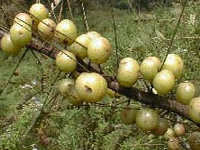Emblica officianalis
Emblica officianalis belongs to the family euphorbiaceae. It is commonly known as Aonla. Amla is the richest source of natural vitamin c. It is highly prolific bearer even without much care. Though there are many hybrids a few namely banarasi, chakaiya, Kanchan, francis, Krishna, NA6, 7, 8, 9 are found to give good quality production.
Cultivation Techniques
Land Preparation |

|
Prior to planting, the field should be deeply ploughed, harrowed and leveled. The pits above 1 metre cube should be dug during May-June at appropriate distance and after 15 to 20 days of exposure to sun are filled with surface soil mixed with 10 to 15 Kg of decomposed farm yard manure. If depressions take place in the pits with the onset of rain, more soil should be added.
Propagation Material
Aonla plant has long been raised from seed and used as rootstock. The seeds attain full maturity by February for which they should be sown in the last week also for getting higher percentage of germination. The best results were obtained by sowing at the commencement of rainy season and subsequently weeding regularly.
Artificial Propagation
The ripe fruits are collected in January and dried in sun, seeds dehisce and are swept up and cleaned by winnowing. It is desirable to use fresh seed as the seeds donot retain viability for long. The seeds need hot water (80°c) treatment for 5 minutes to hasten germination which takes about 10 days.
Planting
Healthy grafts or budded plants are planted during rainy season preferably during the early monsoon in July with square system.
Transplantation
Seedlings of 5 - 10 cm.s height are picked out in polythene bags in the evening. Plants are transplanted in the field in the second year.
Spacing
Best results are obtained under a spacing of 4m x 4m.
Vegetative Propagation
Selected varieties are vegetatively. propagated by budding, in arching or by rooted cutting. These plants start fruiting in 5 - 6 years. Budding has been found to be most practical and shield budding is the commercial method. The most important factor is proper selection of mother plant which is highly fruitful and the bud should be taken from such a branch which has good number of female flowers.
Irrigation
The young plants require watering during summer months at fortnightly interval, particularly till they have been fully established. Watering of mature, bearing plants is also necessary from April to June at bi-weekly interval to secure higher fruit set and reduced fruit drop. Irrigation during October to December at 20 days interval helps in better development of fruits.
Manuring
The young plant should be given 15 - 20 kg of well rotten farmyard manure and the mature tree 30 to 40 Kg each year during September - October. Every mature tree should also be fertilized with 1Kg Super phosphate and 1-1.5 Kg muriate of Potash. The above fertilizers should be given in two equal split doses to mature, bearing tree, once during September-October and again during April-May. After setting of fruits the plant needs to be irrigated after fertilizer application.
Disease and Pest
Aonla rust (ravenellia emblica) - spraying z - 78 at 0.2%
Blue mold - (Pencillium islandicum) Weak Borax or Sodium Chloride
Rotting- (Pencillium oxalicum & Asperigillus niger)
Bark eating caterpillar (Indarbela Sp.) Spraying 0.03% Endrin or injecting Kerosene oil or petrol in the holes and plugging them with cotton or wet soil during September - October.
Shoot gall maker (Bethusa stylophora) - Spraying 2% parathion is suggested to kill the larvae.
Weeding
The seedling or vegetative saplings require clean weeding, soil working for about two years for successful establishment and fast growth.
Harvesting
Aonla has been usefully cultivated and many varieties such as Banarasi, chakaiya, Hathijhol and Bansi red have been developed which have useful properties. Aonla plants start bearing quite late usuallt after 4-5 years. The fruits are light green at first, but when they mature the colour becomes dull, greenish yellow or brick red. Best time of harvesting aonla fruits is February when the fruits have maximum vitamin content.
Yield
A full grown grafted aonla tree with good bearing habit yields from 187 to 299 kg fruit per year. Average fruit yield is 200kg per grafted tree.
Economics
The demand of aonla fruit by various commercial pharmaceutical companies has taken an upward swing and there is enough incentive for tribals to collect the fruit. The average price offered for green fruits is Rs3 to 4 per kg. Panna aonla is famous for its bold size and absence of fibres. |

